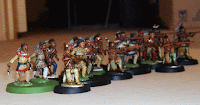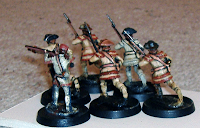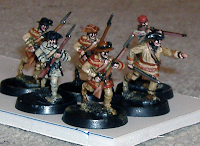
I'm starting to look at building Fort Niagara.
It's quite an unusual fortification for the French and Indian War. Most of the larger forts that the French built were more like that at Ticonderoga/Carillon, being basically a square plan with a bastion at each corner. A ravelin might cover a gate or push the defences deeper out into the surrounding terrain.
Niagara was a rather different story. Originally a rather dilapidated wooden stockade surrounding a few buildings, the French engineer Pouchot decided that he would wall in the point on which the fort would sit. That original trace may be observed in the fort today.
He built what is basically a crown-work of two demi-bastions connected by a curtain, with a large bastion covering the gate. The bastion stood in a ditch, but the lunettes either side of it that supported the covered way stood on the salient places d'armes, proud of the ditch. On closely examining the diagram and the cross-sections, it also seems to me that a shallow ditch was excavated in front of these as well, but that it was not part of the main ditch.
Much of the work was built of material excavated (as can be seen in the cross-sections in the image above) from the ditch. Obviously, the forts defences are oriented eastwards as that was the most likely avenue of attack, although the northern and southen walls were fortified to a degree with retrenchments and stakes.
The fort had two major short-comings.
The first was that it's guns were mounted to fire "en barbette" or straight over the parapets which offered the gunners little cover as the British advanced their saps. This was largely overcome by building merlons from sand-bags.
The other was that there were no bomb-proof shelters for the troops, and thus the garrison suffered quite a few caualies from British mortar bombs and also became progressively exhausted due to not being able to rest.
I'll be using this illustration and others I have to start planning my own model of the fort in coming weeks and months, so watch this space.
 They are the ever-reliable RSMs, straight out of the relevant Blanford and lovely to paint. I decided to do a representative few from each of the light companies present at la Belle Famille. The sharp eyed among you will notice that the pants on a couple of the figures are white. I was looking for a means of adding a bit more variety to the very-similarly uniformed troopers and remembered the 44th wore white small-clothes in their fatal encounter on the Monongahela, ans so it went. I'll be repeating this experiment on their cousins in the Line companies as well to difference them from the men of the 46th.
They are the ever-reliable RSMs, straight out of the relevant Blanford and lovely to paint. I decided to do a representative few from each of the light companies present at la Belle Famille. The sharp eyed among you will notice that the pants on a couple of the figures are white. I was looking for a means of adding a bit more variety to the very-similarly uniformed troopers and remembered the 44th wore white small-clothes in their fatal encounter on the Monongahela, ans so it went. I'll be repeating this experiment on their cousins in the Line companies as well to difference them from the men of the 46th.




